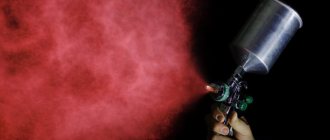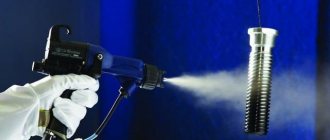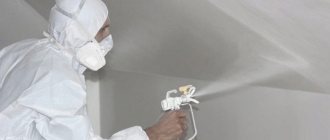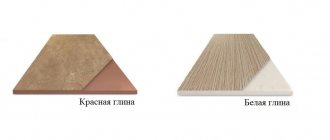The structure and principle of operation of a neon lamp.
Neon lamp design.
The device is extremely simple: 2 electrodes, a glass bulb in the shape of a tube with neon under low pressure.
The operating principle is also not very complicated. Under the influence of electricity, a neutral neon molecule “gives up” an electron from its outer orbital. The remaining particle turns into a cation - an ion with a positive charge. After ionization, the cation moves to the negative cathode, and the electrons move to the positive anode. Current flows through the tube.
As they move, cations and electrons constantly collide. There is an exchange of energy. If the electron receives it, it goes to a higher orbital. Heat is released into the external environment. If an electron loses energy, it descends to a lower orbital. This causes a glow - the release of photons. As a result, the tube glows red-orange.
Where does the light come from in a neon lamp?
The atoms in a neon tube are in motion and constantly collide, transferring energy to each other. This generates a lot of heat. While some electrons escape from their atoms, others become excited—that is, they move to another, higher energy level. The fact is that an electron cannot be located anywhere near an atom, but only at a level corresponding to its energy. It's like climbing a ladder—the excited electron receives enough energy to climb to the next step. The electron can also descend back to its ground state by releasing this excess energy in the form of a photon, a particle of light. The color of the light depends on how much the excitation energy differs from the original one. Like the distance between the steps of the stairs, this value has its own intervals. Thus, each excited electron of an atom emits its own characteristic wavelength of light. In other words, each noble gas has its own characteristic glow color. Neon is a reddish-orange color.
Obtaining a different spectrum of light.
Neon lamps are gas-discharge lamps. The neon tube itself glows red-orange. To obtain other colors, other gases of Group VIII of the Periodic Table are used. Helium produces white-orange light, argon produces lilac light, krypton produces blue-white light, and xenon produces blue-white light. However, they are still called neon.
Different colors of gas discharge tubes.
Two methods are used to obtain other shades. In the first case, several gases are mixed. Sometimes small amounts of blue-green mercury vapor are mixed in. As a result of mixing gases, many different shades are obtained.
In the second case, a layer of phosphor is applied to the walls of the glass flask. When current flows, the lamp will glow in different colors.
Getting different glow colors
Any substance in the plasma state produces a glow belonging to a certain segment of the radiation spectrum. For example, helium produces a yellow stream of light, argon produces blue light, krypton produces greenish light, and neon light is characterized by a red-pink tint. The following methods are used to create specified color variations:
- To the main neon gas, others are added with their own characteristic shade. For example, mixing different amounts of krypton into a lamp can produce different yellowish light.
- Change the parameters of the electric current. A decrease in current density shifts the emission spectrum to the orange region, and an increase - to the blue region.
- The composition of the phosphor is varied.
Characteristics and types of neon.
Gas discharge light sources.
A neon lamp operates using low current. It operates on alternating and direct voltage. In the first case, the entire tube glows, and in the second, the area near one electrode.
Due to the low inertia, dimming is possible based on the pulse width modulation (PWM) mechanism.
The service life is long: about eighty thousand hours. It is limited by the properties of the flask: darkening from the electrodes and gas absorption. In principle, a gas-discharge lamp cannot burn out.
The tubes vary in diameter: 8, 10, 12, 15, 20 mm lamps are available. The higher the diameter, the longer the light source. For eight-millimeter neon tubes, the length ranges from one to seven meters. For ten-millimeter ones: from 1.2 m to 8.2 meters. With a diameter of 12 mm, the length varies from one and a half to ten meters. A tube with a circumference of 15 mm will be from two to 12.5 meters long. A light source with a diameter of 20 mm has a length from 2.5 to 20 meters.
During production, tubes of different shapes and sizes are made. Even in the form of letters in the most intricate fonts. Their diameter varies from five millimeters to two centimeters.
For home lighting, miniature tubes are produced: from 10 to 18 millimeters. This allows lamps to be mounted in hard-to-reach, narrow spaces.
Neon lamps come in different types. They are called neon because of their similar color and soft glow.
Flexible neon.
They consist of a polyvinyl chloride (PVC) tube and LED garland. Depending on the type of PVC they will be matte or transparent. By type of LEDs - single-color or multi-color.
Flexible neon.
Flexible neon is characterized by a constant light. To complicate the work - producing flickering and blinking - special controllers are built into the electrical circuit.
Advantages of flexible neon over tubes:
— mechanical resistance;
- waterproof;
— ease of installation;
- decorativeness;
- low price.
Cold neon.
Structurally different from usual. It is a flexible copper wire painted with a special phosphor. A dielectric layer is applied on top of the phosphor and thin contact wires are wound. The structure is protected from above by a polyvinyl chloride shell.
Cold neon device.
Current is supplied to the center wire and to the wound wires. When electricity flows, a magnetic field arises in which the phosphor begins to glow. The light is very soft, similar to the light of gas discharge lamps. Depending on the composition of the phosphor, different colors are possible. This wire is very flexible, thin, and shines continuously along its entire length and around itself. It is beautiful, waterproof, durable.
Cool neon colors.
Cold neon operates at an alternating voltage of several hundred volts with a frequency of 500 to 5500 Hz. Therefore, connecting to a home network is not possible. Special converting inverters are used. Depending on the model, they can operate from different power sources.
Neon indicator lamps.
Due to the low current consumption, they serve to indicate that the normal mains voltage is turned on. The device is a three-electrode (one anode and 2 cathodes: indicator and auxiliary) small-sized gas-discharge lamp. Voltage is supplied to the indicator contact - the lamp shines brightly - the network is 220 V. To the auxiliary cathode - it goes out - human intervention is required.
Indicator lamp.
Indicator lamps are easy to maintain, reliable, cheap, and last a long time.
How are other colors of neon light produced?
Yes, you've probably asked yourself this question, because neon lamps can glow in a simply unimaginable number of colors, and not just the banal red-orange.
There are two main ways to obtain a specific color
The first is to use another gas or even a mixture of several, because as mentioned earlier, each noble gas has its own glow color. Helium, for example, glows pink, krypton glows green, and argon glows blue. If you mix them, you can get intermediate colors.
Another method involves coating the glass tube with phosphors or other chemicals that will glow a certain color when exposed to plasma energy. But due to the emergence of a wide range of available coatings, neon lamps have been greatly replaced by fluorescent lamps, in which the phosphor glows due to ultraviolet radiation produced by the passage of an electric arc through a mixture of argon and mercury vapor. In neon lamps, no such discharges occur - their electrodes “smolder” decorously and hardly heat up - it’s not for nothing that neon tubes are also called cold cathode lamps. It is this characteristic of neon lamps that explains their high reliability and durability. And for the human eye, the pure glow of the noble gas is much more pleasant.
In fact, there is another way to control the color of a neon lamp, although it is not really used in lighting. By influencing the energy levels available to excited electrons by changing current density or frequency, neon can be made to glow redder or, conversely, shift to the blue region of the visible light spectrum.
HomeBlog about interior designInterior design informationNeon lighting in apartments and houses PROMOTION When ordering a design project - a video as a GIFT! Examples.
Content:
What is neon lighting?
This type of lighting refers to a gas-discharge lamp in the form of a tube, which is filled at low pressure with neon, an odorless, monatomic inert gas through which current passes.
The “native” backlight color is orange-red. Neon lighting often refers to similar lamps filled with other inert gases to produce different colors.
Neon strip lighting was especially popular in the 80s. In those days, it was most often used in clubs, cafes, and cinemas.
Fashion tends to come back; and today lighting is used in modern interiors, effectively complementing them and giving them a special charm.
It is notable for the fact that it can be of different shapes - therefore signs, letters, patterns, images, and geometric shapes are created from it. This property allows designers to implement many interesting ideas.
Advantages and disadvantages of neon lighting
- Uniform illumination without dark areas, spots or breaks in the tube.
- Possibility of installation even in hard-to-reach areas.
- Takes different forms.
- Choice of colors.
- Moderate brightness, not irritating to eyesight.
- Soft glow.
- There is no noise during operation.
- Does not heat up more than 40⁰ C.
- Safety for vision and the environment.
- Long service life.
It should be taken into account that neon interior lighting will illuminate construction defects on surfaces, so there should not be any.
The durability of such lighting is not high enough, so it should be installed out of the reach of children.
Caution should be exercised if neon lighting is provided in the bathroom. In this case, it should not come into contact with water sources. Therefore, its use in this room is limited. It is better to arrange it on the ceiling, as a complement to the main lighting.
Options for using neon lamps in an apartment
Neon lighting in an apartment can be used as follows:
- Illumination of stretch, suspended or multi-level ceilings.
- Cornice (molding) lighting.
- Illumination of wall panels, columns.
- Illumination of the floor, walls, podium, steps.
- Neon lamps.
- Design of niches, partitions.
Let's consider the most common options for using such lighting.
- Ceiling
Neon ceiling lighting will effectively highlight various ceiling structures - geometric shapes, protrusions, levels. If you make a slit type of lighting (the light is visible, but the lamps are not), the space of the room will visually increase and you will get the effect of “floating” of the illuminated ceiling elements. This is an excellent choice for small rooms.
Neon lamps are often used as the main lighting, choosing the desired color and shade.
Side lighting is used as additional lighting. When implementing this option, it is especially important that the coatings are free of construction defects.
When using neon on a bedroom ceiling, it is important to keep the lighting dim. Choose a calm color, for example, blue-white, light lilac. The environment should be conducive to sleep and rest. For some people, the effect of floating on the ceiling helps them fall asleep faster.
- Floor
Floor lighting most often complements the lighting of the ceiling and cornices. With its help, you can zone rooms, illuminate the floor around the perimeter, and create various shapes.
Typically, a slot type of lighting with a floating effect is used for installation around the perimeter of the floor and an open type for creating different shapes.
When installing floor lighting, it is important to follow safety precautions. Lamps must be reliably protected from moisture and mechanical influences. Therefore, for the floor you need to purchase neons with a high degree of protection. Brightness should be moderate so as not to irritate the eyes.
Floor lighting sometimes serves as a guide in a room when the main light is turned off; if it is bright, it will only get in the way.
Neon floor lamps are not used in the bathroom due to contact with water. The bedroom is also not the best option - the floor light is located closer to eye level, in contrast to the ceiling and cornice light.
An LED floor can be installed in the living room, corridor, hallway, kitchen - in the latter case, the floor is often illuminated in the kitchen area.
- Cornice
In such use cases, neon room lighting serves as additional lighting. In combination with the main light, the result is bright and solemn lighting - a good option for a living room where people spend time with friends or family.
The combination is also used in the bedroom, but more often alternately. When getting ready for bed or watching a movie, curtain rod lighting will be enough.
In the bedroom it is advisable to install a slot type of cornice lighting, in the living room - at your discretion.
An open neon strip applied along the perimeter of the cornice will create a festive atmosphere and be combined with many modern or revived interior styles from the past - avant-garde, hi-tech, pop art.
Connection diagram for neon lamps.
Gas-discharge light sources are connected to the power source through a resistor. It is inserted into the circuit to limit the current to 1 mA (or better, to tenths of a milliampere). Low current increases service life. Operating a gas discharge lamp without a resistor poses a threat to human health. The use of a resistor prevents the transition of the discharge to an arc, which can lead to a short circuit and explosion of the lamp tube. The design of some light sources immediately includes a resistor: it is mounted in the base. It is worth carefully studying this issue when purchasing.
Discharge lamps require high voltage. A household outlet does not do this. A step-up transformer is required. Its parameters depend on the dimensions of the lamps, their quantity, and the filling gas. The required voltage varies from 2000 V to 12000 V. For example, for lamps filled with neon there is the following dependence of voltage on length.
| Transmitter voltage, kV | Tube diameter, mm | ||||
| 8 | 10 | 12 | 15 | 20 | |
| 12 | 7000 | 8200 | 10000 | 12500 | 18000 |
| 10 | 6000 | 7000 | 8000 | 11000 | 15000 |
| 0,9 | 5500 | 6300 | 7500 | 9500 | 13500 |
| 0,8 | 4700 | 5400 | 6300 | 7400 | 11000 |
| 0,7 | 4100 | 4800 | 5800 | 7500 | 10500 |
| 0,6 | 3600 | 4000 | 4900 | 5800 | 8800 |
| 0,5 | 2900 | 3300 | 4000 | 5000 | 7300 |
| 0,4 | 2200 | 2500 | 3200 | 4000 | 5800 |
| 0,2 | 1000 | 1200 | 1500 | 2000 | 2500 |
| Transmitter voltage, kV | Tube diameter, mm | ||||
| 8 | 10 | 12 | 15 | 20 | |
| 12 | 7000 | 8200 | 10000 | 12500 | 18000 |
| 10 | 6000 | 7000 | 8000 | 11000 | 15000 |
| 0,9 | 5500 | 6300 | 7500 | 9500 | 13500 |
| 0,8 | 4700 | 5400 | 6300 | 7400 | 11000 |
| 0,7 | 4100 | 4800 | 5800 | 7500 | 10500 |
| 0,6 | 3600 | 4000 | 4900 | 5800 | 8800 |
| 0,5 | 2900 | 3300 | 4000 | 5000 | 7300 |
| 0,4 | 2200 | 2500 | 3200 | 4000 | 5800 |
| 0,2 | 1000 | 1200 | 1500 | 2000 | 2500 |
To supply such a high voltage, high-voltage wires are needed. Their insulation must withstand at least 1.5 hours of operating voltage. As an example, let's take the PMVK wire. It is inexpensive, can withstand up to 20 kV, and operates from -60 to +80 degrees.
Remember, to connect neon lamps yourself, you need good electrical knowledge. Working with high voltages requires a high level of electrical safety. Don't forget about your own safety!
There are two schemes for connecting lamps to a transformer. The first of them is standard. The lamps are connected in series to the transformer, and the transformer to a 220 V network.
Standard electrical diagram.
Zero point circuit.
The lamps are connected in two groups on opposite sides of the transformer. An equal number of light sources of the same type are used (in terms of size, gas filling).
The zero point circuit allows you to reduce the length of the wires. If one lamp breaks down, only one part of the circuit will stop working, and the second will continue to shine.
Due to its design, cold neon consumes less energy than regular neon. It can be powered from a low voltage power supply. To create the necessary electrical parameters (voltage, frequency), an inverter is built into the circuit. Depending on the model, inverters can be powered by twelve-volt power supplies or five-volt batteries. Up to three meters of neon can be connected to the batteries. And to the 12 Volt power supply - up to twenty meters.
Connection diagram to a power source via an inverter.
When installing, follow these simple rules:
- Wires and lamps should not come into contact with metal. If necessary, use polycarbonate holders.
- If two or more transformers are used, the wires from them are separated at a distance of more than 20 cm.
- The place where the wires pass through the metal is placed in a PVC pipe.
- All metal parts and the transformer must be grounded.
Switch illumination circuit for a neon light bulb (neon)
The backlighting circuit for a switch on a neon light bulb (neon) is devoid of the disadvantages inherent in the LED backlighting circuits presented above. This switch illumination scheme is suitable for chandelier switches and any other types of lamps, with both incandescent light bulbs and energy-saving fluorescent and LED lamps installed in them.
When the switch is open, current flows through resistance R1, the discharge lamp HG1 and it lights up. R1 of any type with a power of more than 0.25 W, rated from 0.5 to 1.0 MOhm.
In the photo you see the assembled switch illumination circuit, which couldn’t be simpler. It is enough to connect a resistor in series with a neon light bulb of any type and the circuit is ready.
Comparison of LED strip with neon.
LED strips.
Gas discharge lamps have several advantages compared to LED strips:
- softness of light (LED – very sharp, contrasting);
- uniformity (LED light sources shine in dots);
- the ability to bend neon in any direction (LED strip bends only in one);
- little or no heating.
However, LED strip consumes less electricity and makes it possible to use more colors. It is also environmentally friendly, whereas gas-discharge light sources may contain mercury vapor.
Main differences from LED strip
The cord, which operates on the principle of phosphor glowing under the influence of an electromagnetic field, just like a gas-discharge tube, emits light 360°, but at the same time bends in any direction and consumes less energy. A flexible strip of LED elements emits light 180° in one direction and bends only in one plane. The advantage of a flexible LED strip imitating neon is its mechanical stability, ease of operation and the ability to control the mode via a controller.
The advantage of LED-flex is its versatility and versatility.
Of course, the RGB strip system is limited by the direction and radius of bending, as well as the narrow vector of the glow, but these shortcomings are compensated by the ability to create unique light shows when using programmable controllers with different operating modes. At the same time, the luminous neon thread is thinner (up to 2 mm), and this allows it to be mounted in narrow joints and crevices, which is important for auto-tuning and decorative upgrades of various devices.
Motorcycle tuning with thin neon thread and thick LED-flex.
It should be added that now the fashion for retro is returning, including analogue, so old gas-discharge lamps do not lose their relevance in the field of design and marketing. Price and difficulty in operation have made classic neon lamps the choice of wealthy buyers who want to stand out with their status and good taste.
Advantages and disadvantages.
Neon tubes.
pros
- low power consumption;
- low heating (up to 40 degrees);
- soft light, lack of contrasting shadows;
- absence of noise;
- easy dimming;
- long service life (80,000 hours or 20 years) no elements capable of burning out;
- Possibility of manufacturing lamps of different shapes and sizes.
Minuses
- low mechanical strength;
- high voltage for connection and operation;
- low brightness of the glow - use for home use only as lighting;
- the need for a step-up transformer;
- increased safety measures during connection and operation;
- safe disposal of lamps containing mercury vapor;
- high price.
Pros and cons of neon lighting
If we consider the advantages, it is worth highlighting the following points:
- a large selection of devices in size and shape;
- installation work is carried out quite quickly, since a large number of components are not required;
- it is possible to control the brightness level and the degree of electrical energy consumption;
- large selection of colors;
- long service life, up to 20 years;
- such elements are fireproof, since heating is completely excluded;
- There is no extraneous noise during operation.
Despite the large number of advantages, there are also some disadvantages. As a rule, the disadvantages include:
- contains components harmful to human health;
- light sources can only work if there is high voltage;
- The lamps are quite fragile, as glass is used in the production process.
Only after carefully studying all the advantages and disadvantages can you begin to choose the appropriate option.
Where are neon lamps used?
Liquid neon is used for cooling in cryogenic plants (air separation plant). Previously, neon was used in industry as an inert medium, but was replaced by cheaper argon.
Neon light sources are used as an indication:
- Control and indicator lamps for the presence of mains voltage 220 V.
- Probe indicators. They are used to detect the presence of alternating voltage on phase conductors (wires) or on the housing of electrical receivers. ATTENTION! Such indicator probes must be connected in series through a 1 MΩ resistor in order to protect a person from electric shock. Low pressure neon lamps are excellent for this task as they have very low current consumption and are therefore very sensitive.
- Balizor - high-voltage signal lamps-markers. A neon light source can flare up without a direct source of electric current, but only when exposed to an electromagnetic field. An example of the use of this property of neon lamps is the Balizor lamp, used for the quality of light indication of overhead lines.
The difference in simple circuit diagrams of signal neon lamps and LED lamps is shown below
Neon indicator connection diagram
LED indicator connection diagram
Neon lamps are also used as an element of overvoltage protection in telemechanics and alarm circuits, provided that the maximum permissible voltage is below the lamp's flare-up threshold, and causes it to glow during voltage surges.
The use of decorative gas-discharge lighting is limited by imagination.
At home, neon is used to create accent lighting on furniture, mirrors, and interior items. This lighting creates a festive atmosphere on any day.
Neon lamps indicate steps, baseboards, and switches.
Neon is used to decorate bars, cafes, and restaurants. Illuminated by gas-discharge lamps, the rooms become cozy. A soft, intimate atmosphere is created.
In apartments and cafes, zoning using gas-discharge lamps is common.
At discos, neon sets the rhythm for dancing. Creates groovy flickering and flashing modes.
On the street, gas-discharge light sources are used to decorate the exterior lighting of buildings, monuments, festive illumination, etc. Airport runways are also illuminated.
Neon is most often used in advertising. A variety of signs and window displays look beautiful in the dark.
Neon letters are available for outdoor and home use.
A photo studio with neon lamps allows you to take beautiful photographs in multi-colored light. Such photo shoots are common in show business and the fashion industry.
What it is?
Neon lamps are bright modern representatives of lighting devices on the market, which are distinguished by their reliability and durability. Thanks to this, they are used in a wide variety of areas, from building lighting to interior lighting of apartment rooms. A neon lamp looks like a glass tube that is filled with a small amount of gas. Gas is driven into neon lamps at low pressure.
Note! Not just any gas is used here. A neon lamp contains neon as an inert gas. This is where its name actually came from. But other inert gases can also be released into neon lamps.
Lamp design
A characteristic feature that all such light bulbs have is that any atom in them has a completely filled electron shell. As a result, neon atoms never interact with other atoms to capture new electrons. Moreover, in order to tear off at least one electron from them, a lot of energy will be required. The glass tube, which is the basis for such a light bulb, has an electrode at each end. A neon lamp can be powered by AC or DC power. But if neon light sources are connected to DC current, neon light will only be observed around the electrodes. Because of this, most often the neon lamp is connected to an alternating current source.
Lamp glow
Note! These bulbs are often connected to high voltage (about 15,000 volts). This voltage is sufficient to remove an electron from the outer orbit of an atom. At low voltages there will be no effect.
The entire operating principle of lamps is based on the properties of inert gases. Neon lamps work as follows:
- when electricity is passed through gas atoms, they lose electrons and acquire a positive charge;
- then such atoms begin to be attracted to the electrode, which is negatively charged;
- the released electrodes are in turn attracted to the positively charged electrode.
Note! All gas particles that have a charge are called plasma. With their help, the electrical circuit is closed.
As a result of this process, neon light of a very bright spectrum is formed. Therefore, lighting organized using such light bulbs is used to illuminate buildings and apartments. Often a neon lamp replaces an LED strip as a light source. Such lighting will be no worse than LED lighting, but neon light sometimes looks even more impressive. At the same time, both the LED strip and the neon lamp can be easily installed with your own hands.
How to make a neon lamp with your own hands.
It is hardly possible to make a full-fledged neon lamp at home. The main difficulty is the lack of commercially available components: inert gases, phosphor, etc. It is problematic to comply with production technology outside the plant.
You will be able to make something like a gas-discharge lamp yourself.
You will need 2 matching colored LEDs and an adhesive stick from a glue gun. The light of your future “lamp” depends on the color of the LED. And from the length of the rod - length.
Don't forget about safety precautions when working with electrical appliances!
Connection diagram similar to a neon lamp.
So, first, using a soldering iron with a thin tip, make a recess at the end of the rod. Place the LED there so that the contacts remain outside. Seal the hole tightly with glue. Do the same on the other side.
Next, use wiring and a soldering iron to connect the negative contact of the first LED to the positive terminal of the second.
Connect the remaining contacts to the power source - you get a glowing device. Its light resembles neon.
The light of the "lamp" on the light; In the dark.
- Related Posts
- What types of LED strips are there and how to choose them
- Where to donate fluorescent (mercury) lamps
- Types of lamps with gu10 base, popular models, technical characteristics
Scope of application
Lamps and cords, which contain inert gases, are used everywhere today. They are used for:
- decorative decoration of rooms;
- creating hidden lighting;
- design of external lighting of buildings, architectural structures, monuments, etc.;
External lighting of buildings
- outdoor advertising lighting;
- runway lighting at airports;
- designing unique interiors in residential premises, retail spaces, etc.
The fairly wide scope of application of this type of product is explained by a number of advantages, among which the quality and beauty of the light flux stand out. Only LED strip can compete with them. By installing neon lamps in your home, you will receive an excellent tool that will help you create a festive or romantic atmosphere in any room. Moreover, thanks to its qualities, the tape can also be used outdoors. It will make your evening picnic unforgettable!
Connecting and installing neon tape
Anyone can connect flexible neon after carefully studying the instructions.
Flexible neon connects to a 220 V network via an adapter. It is advisable to use only original components from well-known manufacturers so that there are no problems using the backlight in the future. It is important to follow safety precautions when working.
Unusual neon LED strip
How to cut flexible neon
A special feature of flexible neon is the possibility of cutting. To do this, manufacturers put marks on the cable along which the cut should be made. There is no need to solder or reconnect anything.
When assembling the chain, sealant is applied between the elements. The structure will be ready for use after it dries.
Connection diagram
Wiring diagram
The connection diagram consists of the following elements:
- flexible neon of the required power and shade;
- network cable with adapter;
- pin-type connector for reliable connection;
- plugs to protect the circuit.
There may be other elements that in one way or another affect the functionality of the backlight and its performance.
How to connect and fasten
Flexible neon is fastened using holders, profiles or brackets. Some methods are suitable for creating curved systems, while others provide reliable straight fixation. The choice of technique depends on what kind of design is needed as a result.
Straight installation
Straight installation
For straight-line installation of flexible neon, you will need to purchase or make a guide profile. The profiles are fixed to the surface with screws in increments of 25 cm.
They are made from different materials: polymer, stainless alloys with minimal conductivity.
Curvilinear installation
Curvilinear installation
Curvilinear installation is carried out using staples or in a pre-calculated groove sealed with sealant. It is better to fasten the brackets to the surface with screws or self-tapping screws.
In the second case, the sealant or silicone should be as neutral as possible so that the surface of the tubes does not change its properties during operation.
Types and colors
Diode neon strips are divided into several types.
Classic
LED neon of this type is used to decorate houses outside and inside. They are durable, inexpensive and receive excellent performance from buyers.
Professional
Such tapes are characterized by a long service life. They are used to create complex lighting projects. This type of illumination lasts several times longer than usual.
Low voltage
The power of this design is 12 volts. It is connected via a power supply. Most often, subtle lighting is used in the manufacture of signs. The sizes of such tapes are usually small. At the same time, they provide quite bright light.
Mini
Such diode strips shine very brightly and are most often used to create large advertising structures. They are very cheap, but at the same time immediately attract attention.
Round
Flexible neon of this type has a high coating density, so it lasts for quite a long time. These LED strips are used to decorate the outside of houses.
Economy
The name of such tapes speaks for itself. This kind of lighting is very cheap. Therefore, many people use it to decorate their homes. The only disadvantage of this type of backlight is that it does not shine as brightly.
Modern neon lighting is available in different colors. The most popular are luminous cords in neutral shades: white, blue, green. You can also choose brighter colors to decorate the room, for example: blue, yellow, red, pink or purple. You can choose the appropriate shade based on the interior design features or the selected background.
Separately, it is worth highlighting the neon “chameleon” type lighting. It is inexpensive, but it looks very bright. LED neon strips shimmer in different colors and are often found in nightclubs.
How can you light up an apartment using neon?
The two main options are neon stripes and lamps. Flexible ribbons look like garlands wrapped in a soft PVC tube. Such lighting can be either different colors or one. The variety of materials used in production provides the buyer with a choice: the tubes can have a matte or transparent coating.
How to choose neon lighting
If you plan to purchase neon lighting, then the first step is to decide for what purposes it will be used:
- for vehicle tuning;
- interior decoration;
- for outdoor advertising;
- as street lighting devices;
- for landscape design.
After this, it is worth taking into account the voltage of the electrical network, the voltage that appears during an electrical discharge, and the maximum current value. Only knowing these indicators can you choose the right option.











